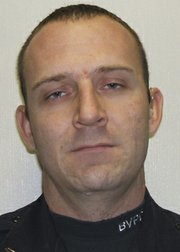BENTONVILLE — Police officers often have trouble “shutting down” after a high-speed chase, an expert in the field said.
Thomas J. Aveni, executive director of The Police Policy Studies Council based in New Hampshire, is familiar with the case of Coleman “Duke” Brackney, who shot James Ahern six times following a high-speed chase in Bella Vista Jan. 20.
The sixth and fatal shot was fired after investigators said it appeared Ahern was trying to surrender. They said Ahern also would not have been able to fire a shot had he had a gun because of injuries suffered from the first five shots.
Brackney was charged with manslaughter last week, and was fired after four years with the Bella Vista Police Department.
Aveni co-founded the council in 2001. The council is a multidisciplinary organization that brings together clinicians, physicians and police practitioners in an effort to clarify complex criminal justice issues, according to the organization’s Web site.
Aveni could not address specifics of the Brackney case, but spoke in generalities about pursuits and the impact on police officers.
“There are issues involved with an officer who’s been in a chase with a heightened state of anxiety,” Aveni said. “The officer has an expectation of danger.”
Aveni’s research into “questionable” police shootings contributed to the creation in 1995 of the first low-light instructor training program offered. By 1998, Aveni’s training was being taught internationally.
The program involves instruction about human vision in low-light environments, low-light operational philosophy and practical live fire exercises for police officers.
“Three quarters of police-related questionable shootings occur at night in low-light circumstances,” Aveni said. “Under those circumstances at night, when you have visual acuity diminished, it adds into the officer’s critical decision making.”
The Ahern shooting occurred about 8 p.m., well after dark in the winter hours, according to the probable cause affidavit.
Police officers also have a hard time rationalizing a person would flee over a minor traffic stop in any type of lighting situation, Aveni said.
“In the officers’ minds, there must be drugs in the car or some other reason not to get caught to risk felony fleeing in a vehicle,” Aveni said. “When the car finally stops, the officer is processing the person’s behavior from that perspective.
“That can sometimes preserve an officer’s life or have them make a decision that later on down the road is deemed to be inappropriate.”
Brackney told investigators, according to the probable cause affidavit, he feared for his life because he thought Ahern was attempting to run over him with his vehicle.
However, Brackney’s dash camera video showed a discrepancy between what Brackney told investigators he thought was happening and how events unfolded, the probable cause affidavit said.
The incident should have never progressed to the point of shots being fired, said John Phillips, who’s with a group called PursuitWatch.org., a group that monitors police pursuits.
Phillips’ organization believes high speed pursuit should only be used when there is imminent and immediate danger to the public, he said.
“It never should have gotten to the point where the officer used his weapon,” Phillips said of the Bella Vista incident with which he was familiar. “Just because an officer tried to pull someone over and he doesn’t stop, doesn’t mean he got away. There are other options where an officer doesn’t have to chase.”
Phillips said police can take down the license and radio it in, call for help or put helicopters in the sky.
“Unless the person has committed a violent crime or robbed a bank, something where he shows disregard for public safety, officers don’t have to chase,” Phillips said. “It’s not worth the risk to the officer and the general public.”
Phillips said Brackney’s actions the night of the pursuit are puzzling.
“This one kind of confuses me,” Phillips said. “It seems like the chase ended, then things took a different twist. Pursuit instances are very difficult to control. There are a million variables. When law enforcement loses control, that’s when they get into trouble.”
Within a career, national statistics show a law enforcement officer draws his gun one time on the average. They spend 70 to 80 percent of the time in a patrol car. Phillips said.
“Yet, when it comes to training, they don’t have the proper amount of training time in the vehicle,” he said.
Training aside, Phillips said, Brackney’s conclusion to engage in a chase was not worth the pursuit based on the initial probable cause affidavit. Brackney said he chased Ahern’s Mazda Miata because Ahern drove away at a high rate of speed with the headlights off.
“I’m not sure why he made the decision to pursue in the first place,” Phillips said. “The bottom line is, this isn’t the Wild West.”
---
The Shots
Police Pursuit Death
According to the State Medical Examiner’s Office, the six shots hitting Bella Vista resident James Ahern were:
• Left thigh: One bullet struck Ahern in the anterior surface of his left thigh in a downward trajectory. The bullet separated prior to entry into the left thigh causing two wounds. The bullet jacket and bullet were recovered in Ahern’s left thigh.
• Right thigh: One bullet struck Ahern in the back right thigh causing a superficial graze wound. The bullet did not penetrate into the thigh muscle.
• Back by armpit: One bullet struck Ahern in the right upper back near the armpit in an upward, back to front trajectory. The bullet separated prior to entry into the right upper back causing two wounds. The bullet fractured the humerus and was recovered in Ahern’s right arm. The bullet jacket was recovered in the skin underlying the wound.
• Right arm: Two bullets struck Ahern in the back of the right arm above the right elbow in a downward direction. One bullet fractured the right ulnar and right radius and was recovered in the right arm. The other bullet fractured the right radius and exited the right arm.
• Upper right back: The final bullet fired struck Ahern in the upper right back and exited through his upper right chest. The trajectory is back to front and slightly downward. No bullet or fragment was recovered
Source: Probable Cause Affidavit
---
web watch
The Police Policy Studies Council
www.theppsc.org


